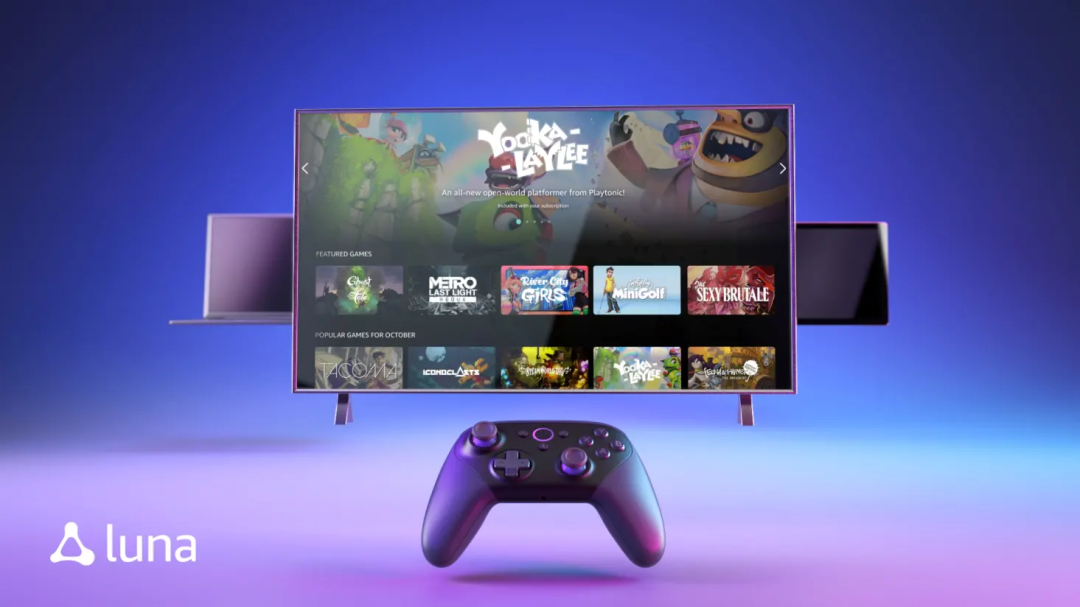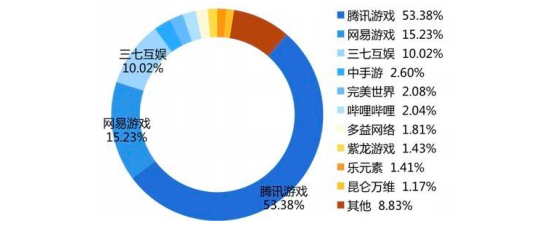ps://36kr.com/projectDetails/8432″ target=”_blank”>Alibaba Cloud, Up to Moyuan recruited senior staff, and then officially released the cloud game PaaS 1.0 platform at the Yunqi Conference in September this year.
According to the vision of this e-commerce company without game genes, Ali will “provide infrastructure and technology to build cloud gaming capabilities to empower customers, so as to provide users with a new game content consumption experience”, and ultimately achieve The purpose of shaping the game industry structure.
Huawei has also been accumulating power in the field of cloud games relatively early, and made its first cloud game product prototype in 2016; in March of this year, it released version 2.0 of the cloud game solution again.
As a domestic heavyweight game manufacturer, Tencent already has multiple cloud gaming platforms, including Tencent Instant, Tencent START cloud gaming, GameMatrix, Tencent Cloud cloud games, etc., and launched a new cloud game solution and “live + cloud game” interactive solution this year.
Games are a rich industry. At the end of last year, Tencent Research Institute Yu Dian predicted: “Cloud games will become a key position for competition in the game industry. Whoever takes the first to occupy the cloud game market will be more likely to grasp the lifeblood of the game industry in the future.” It can be seen that even if it is successful in the game industry Tencent has also felt the new pressure.
For large foreign companies with strong funds, what should be moved has already been moved.
Following Google Stadia, Microsoft ProjAfter ect xCloud and Nvidia GeForce Now, this week Facebook launched cloud gaming services for its billions of users for free. Amazon also launched the cloud gaming platform Luna at the end of last month, which can be “early experience” starting last week.
Amazon’s Luna uses a progressive web application (PWA) solution, which does not need to be downloaded through the App Store, and can be launched using only a browser. As a web application, Luna perfectly circumvents Apple’s cloud game rules and provides the possibility to reshape distribution channels. After all, companies such as Google, Nvidia, and Microsoft have been suffering from Apple for a long time. If they can bypass the Apple Store to download these games, the entire profit structure will indeed change because of cloud games.
The theory has already taken shape, why did you borrow Dongfeng this year
“The technical threshold of cloud gaming is actually quite high.”
Cloud gaming brings most of the processing of the game process from the player’s host to the data center, allowing game lovers to play games anytime, anywhere without being restricted by hardware.
Cloud gaming technology is actually not that new. G-Cluster proposed this concept in 2000, and Sony also proposed the “Play anywhere” concept when it announced the PSP in 2003, hoping to “put the console in your pocket!” A few years later, OnLive officially launched Cloud gaming service.
OnLive did a demo of “Crysis” at GDC in 2009. The demonstration effect at that time made OnLive become famous for a while, and it attracted 100,000 users to make appointments during the test period. Unfortunately, OnLive only lasted for 5 years: from its official release in 2010 to the closure of its service in 2015. With the bandwidth conditions at the time, even if the video resolution is compressed to 720p, it can only operate normally in a completely idle network environment. Once someone shares the network, it will be unsustainable. Therefore, the bad experience makes OnLive’s reputation rapidly decline.
Nvidia launched its cloud gaming platform GeForceNow in 2017, but Nvidia CEO Huang Renxun believes that cloud gaming will never replace gaming PCs. The reason is that the delay cannot be broken: “When you play some competitive games, you usually need to Respond in milliseconds, not hundreds of milliseconds. This is a fundamental problem, a law of physics.”
“Delay” is also a major obstacle to the initial development of cloud games. E-sports fans are most sensitive to delays during the game.
Compared to other segmented scenarios, cloud gaming also has the highest real-time requirements. The delay of the live video broadcast is allowed to be between 5 and 10 seconds. If the network is not good, it can be cached for a period of time in advance. The communication between people such as video conference is basically within 500 milliseconds, and the problem is solved by introducing cache under the network jitter. However, the latency requirement of cloud games must be within 100 milliseconds, or even within the interval of 10-20 milliseconds. The packet sending strategy cannot be based on caching. More radical network transmission protocols are required, such as the introduction of RTC technology. Obviously, the real-time audio of cloud games The technical challenges of video communication are even greater.
In recent years, major manufacturers have been constantly optimizing technology at the bottom level, superimposing the tuning of various links to ensure fluency. “If the previous links are optimized to the extreme, it can reach within ten milliseconds. For example, the webRTC link can be adjusted to the level of several milliseconds through the tuning of technical strategies. Both Nvidia and AMD have invested a lot of resources in cloud games. R&D, hardware rendering and transcoding can also be reduced to a few milliseconds.” Li Yutao said, “All nodes are deployed in the same city as users, and users can access nearby. With the blessing of 5G technology, one can achieve one. Within milliseconds.”
Make an alliance while “smashing money”
Although Huang Renxun believes that cloud games “never” will be as good as PC games, this does not affect Nvidia’s strategic deployment and continued investment in cloud games.
At the 2019 SCE, Huang Renxun revealed the status of Geforce Now, expressing his satisfaction with the support of tens of thousands of concurrent users. The general manager of Nvidia Cloud Games also said, “This is a brand new business model that completely subverts traditional games.” “Nvidia’s goal is to become the Netflix of cloud games. The sooner we participate in it, the more benefits we will get.”
Faced with the opportunity that the game market may be reshuffled and allocated, hardware vendors, cloud service providers, operators, and game manufacturers in the entire chain dare not just wait and see.
However, today’s cloud games can only be played by big manufacturers. Because the early investment required is very large.
Excluding R&D costs, operating costs alone limit the players who can enter the game. A high-end GPU graphics cardIt is more expensive than several servers combined, and cloud gaming requires a lot of GPU and computing resources. There is also the investment in bandwidth. For cloud game service providers, to serve so many users, they need to pay the operator an export bandwidth cost, which is also very high so far. At the same time, in the construction of the underlying infrastructure, it is also necessary to deploy more cloud computing or edge nodes in cities closer to users to reserve more bandwidth resources. Each node represents a huge investment.
(7500 nodes of Google Cloud)
Li Yutao said: “Calculation cost and bandwidth cost are the two major constraints. Future cloud game development To get up, you need to do extreme compression in these two areas.” Companies like Tencent can also rely on their own accumulated technical advantages, use codec technology to compress bitrates to reduce bandwidth, and use virtualization technology to maximize the use of graphics cards. The degree of cost reduction…
Game copyright is another bigger constraint. Without copyright, there is no way to operate cloud games, and currently only a few major manufacturers own game copyrights. And making games is similar to Tencent Video, Long video industries such as iQiyi and Youku are heavily invested in copyright, and they invest a lot in content creation every year.
On the long chain of cloud gaming, no company can do it all. Few companies have the three elements of cloud gaming like Tencent and Microsoft: cloud computing, real-time audio and video transcoding technology, and game IP. Other manufacturers mainly focus on a certain field or take advantage of a certain main business advantage. For example, Huawei mainly supports server and cloud computing business, and Sanqi Mutual Entertainment aims to reserve the development and distribution methods of next-generation games. “We hope to use cloud Games break the ceiling of the main business,” said the vice president of Sanqi Interactive Entertainment.
(Mobile game market share in the first half of 2019)
“Cloud games will generate huge value and will have a huge impact on the industry ecology including games” has become a consensus. After two years of deployment, content parties and technology parties are using their own advantages to cooperate.
In June 2019, NetEase Thunderfire and Huawei established the “Huawei & NetEase 5G Cloud Game Joint Laboratory”. Sanqi Mutual Entertainment signed a cooperation agreement with Huawei in 2020, and the two parties established a “cloud game technology solution joint research team.” In March of this year, the Huawei Developer Conference 2020 was held online. Huawei officially announced that it has reached a strategic cooperation with Tencent Games and established a joint laboratory. The two sides will conduct in-depth cooperation in cloud games and mobile cloud engines. Tencent Cloud and Douyu jointly launched a live interactive cloud game solution…
Inadvertently, alliances between major companies can form an ecosystem. There is one Ali, and I don’t know what to do next.



